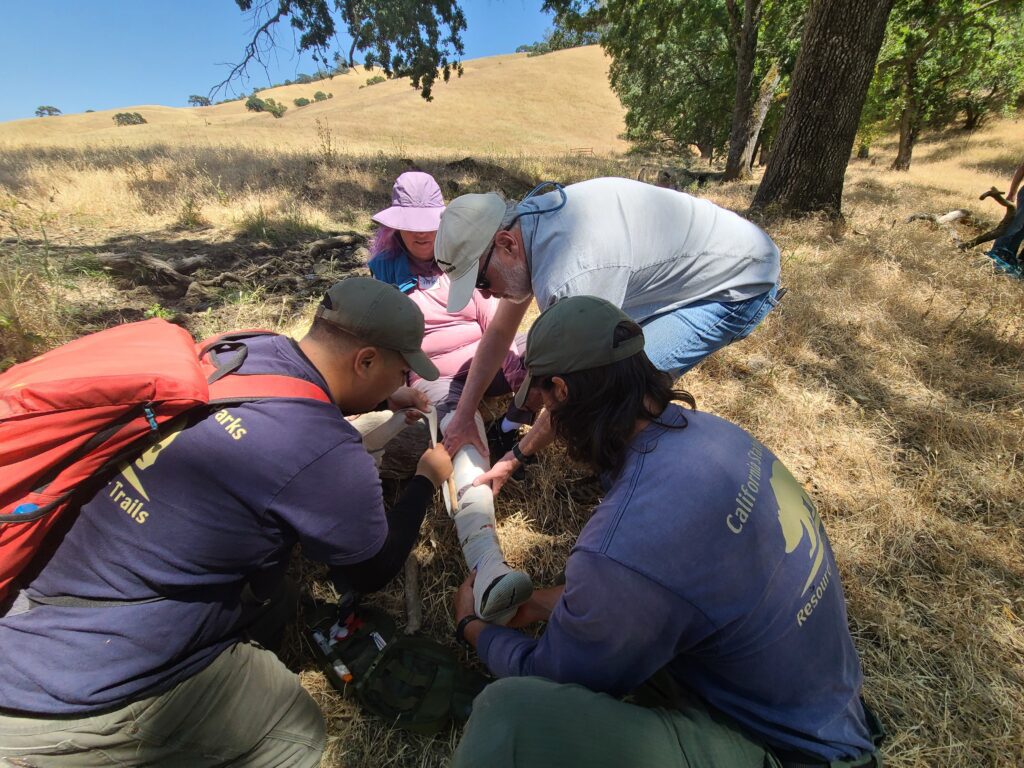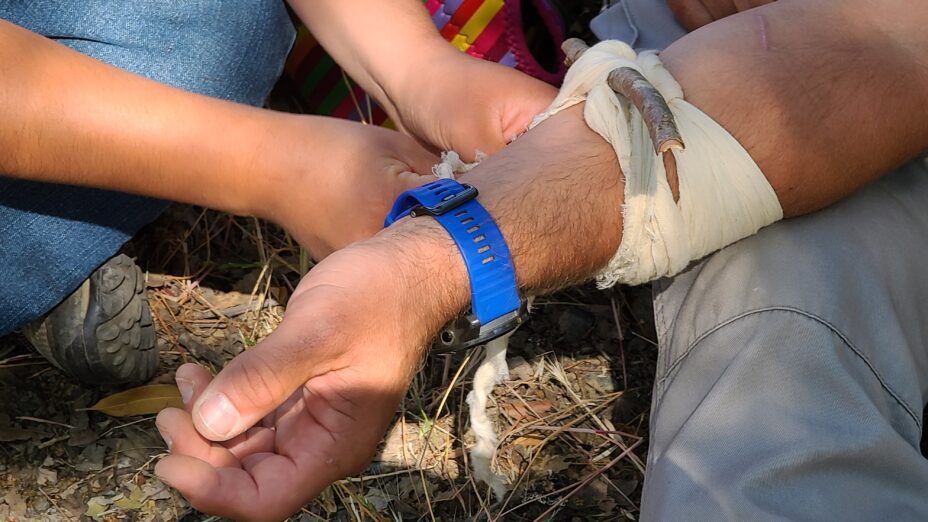
There are many great resources on what to keep in a general first-aid kit, like one you might keep in your car, at home, or work.
But those are often quite bulky and much too impractical to carry on day outings or even light backpacking trips.
That said, a certain level of preparedness is always recommended, because even in a more urban setting like the Mount Diablo area, it’s possible to end up in an emergency. And you might not be able to reach help.
In California, hikers and outdoor enthusiasts often encounter specific medical issues because of the diverse terrain, weather conditions, and activities available in the state.
Common Medical Issues

Trainees apply bandages and an improvised splint to learn how to treat a common leg injury in the outdoors. Photo by Alexander Broom
Here are some common medical issues seen among hikers and outdoor enthusiasts in California.
- Sprains and strains: Uneven terrain and strenuous activities can lead to ankle and knee sprains or muscle strains.
- Cuts, scrapes, and abrasions: While exploring rocky trails or engaging in outdoor activities, minor cuts, scrapes, and abrasions are common.
- Blisters: Long hikes or ill-fitting footwear can cause blisters, especially in hot and dry conditions.
- Dehydration: California’s dry and warm climate can lead to dehydration, especially during summer hikes.
- Heat exhaustion and heatstroke: High temperatures and strenuous activity can lead to heat-related illnesses.
- Allergic reactions: Exposure to plants, such as poison oak, or insect bites can trigger allergic reactions.
- Insect bites and stings: Mosquitoes, bees, and other insects can be bothersome and may cause allergic reactions in some individuals.
- Sunburn: Prolonged sun exposure without adequate protection can result in sunburns of varying intensity, with some being medically significant.
- Altitude sickness: In higher elevations and mountainous regions, some hikers may experience symptoms of altitude sickness, such as headache, nausea, and dizziness.
- Hypothermia: In colder regions or during unexpected temperature drops, hikers may be at risk of hypothermia.
- Wildlife encounters: Interactions with wildlife, although rare, can lead to bites, scratches, or other injuries.
- Poisoning: Ingestion of toxic plants or contaminated water can lead to poisoning.
- Fatigue and overexertion: Long hikes and strenuous activities can lead to exhaustion and fatigue.
- Falls: Slips, trips, and falls are common outdoor hazards, especially on rugged trails.
- Inadequate foot care: Improper foot care can lead to fungal infections and other foot-related issues.
Though some of these issues are treatable in the field, some of these will be genuine emergencies, and you’ll need to go get help as necessary.
First Aid Guides and Training
It’s always a great idea to keep a waterproof first-aid field guide handy to help you make decisions in these situations. Likewise, we absolutely recommend seeking training from certified schools or instructors, because you cannot be too prepared.
Save Mount Diablo recently offered a wilderness first-aid training course through Backcountry Medical Guides for our staff and volunteers. Much of our expertise in this area comes from them, so we’d like to offer a big thank you to its incredible staff.
Wilderness First-Aid Kits
Backcountry Medical Guides also offers its own wilderness first-aid kits with many of these
products and more, if you’d rather get a turnkey setup.

What you’ll find in the wilderness first-aid kits offered by Backcountry Medical Guides. Photo by Backcountry Medical Guides
Here’s our list of items you may want to keep handy and what they’re generally helpful for.
- Adhesive bandages: Essential for covering small cuts, blisters, and abrasions that may occur while navigating rocky or uneven terrain.
- Sterile gauze pads and adhesive tape: Necessary for dressing larger wounds caused by falls or accidents during outdoor activities.
- Moleskin or blister pads: Crucial for preventing and treating blisters on the feet.
- Pain relievers (ibuprofen or acetaminophen): Helpful for relieving minor aches and pains resulting from muscle strains, overexertion, or minor injuries.
- Antiseptic wipes or alcohol pads: Critical for cleaning wounds and preventing infection after encountering dirt, plant material, or contaminated surfaces.
- Insect repellent: Used to protect against mosquito bites and potential vector-borne diseases while exploring outdoor areas.
- Sunscreen and lip balm: Essential for protecting the skin and lips from sunburn, especially during extended periods of sun exposure in California’s sunny climate.
- Oral rehydration salts or electrolyte packets: Important for rehydrating and replenishing electrolytes during hot weather and strenuous activities to prevent dehydration.
- Elastic bandage (such as an ACE bandage): Valuable for supporting sprains, strains, or other injuries during outdoor adventures.
- Tweezers: Handy for removing splinters or ticks that may attach to the skin during hikes or exposure to grassy or wooded areas.
- Scissors or a knife: Useful for cutting gauze, tape, clothing, or other materials when administering first aid.
- Antihistamines (for allergic reactions): Critical for managing mild allergic reactions to insect bites, stings, or plant exposures commonly encountered in outdoor environments.
- Triangular bandage: Versatile for creating slings to support injured arms or stabilizing injured limbs until professional medical help is available.
- Emergency blanket: Important for providing warmth and protection from cold temperatures or unexpected weather changes during outdoor trips.
- CPR face shield or mask: Essential for personal protection while performing CPR in case of cardiac emergencies.
- First-aid manual or instructions: A small booklet offering guidance on basic first-aid procedures to handle various medical issues encountered during outdoor activities may be at the top of your priorities.
- Personal medications: Bring any prescription medications, such as asthma inhalers or allergy medications and EpiPens, which you might need during the trip.
- Splints*: SAM (structural Aluminum malleable) splints are versatile, lightweight, and easy to shape according to the injured limb’s contour. They are particularly useful for stabilizing fractures and sprains.
- Tourniquet kit*: These are useful for slowing blood loss when properly applied, just be sure to note the time of application if you find yourself using one.
*You may be able to improvise certain items on this list, so it’s well worth it to prioritize these items to suit your individual needs.

Trainees apply an improvised tourniquet to a simulated wound. Photo by Alexander Broom
Emergency Locator Beacons
Emergency location beacons (ELBs) or personal locator beacons (PLBs) are also valuable devices to consider including in your wilderness first-aid kit.
These devices are designed to transmit distress signals to search and rescue authorities in case of an emergency, even in remote or isolated areas where there may be no cell phone coverage.
When activated, they can greatly expedite the rescue process and increase the chances of a successful outcome during critical situations.

A diagram from the National Oceanic and Atmospheric Administration on how emergency beacons work. Photo: NOAA
Including an ELB or PLB in your wilderness first-aid kit is a smart move, especially if you plan to engage in outdoor activities in remote or challenging environments.
It provides an extra layer of safety and can be a lifesaving tool in emergencies where timely help is crucial. Just remember to register your ELB or PLB with the appropriate authorities before using it, and familiarize yourself with its operation and features.
Additionally, some smartphones have advanced emergency features that allow users to send distress signals or share their location with contacts in emergencies.
These features often require cellular or mobile data service, but there are exceptions like the iPhone 14 lineup, which can connect directly to a satellite.
By including these items and their descriptions in your wilderness first-aid kit, you’ll be better prepared to address the most common medical issues faced by hikers and outdoor enthusiasts in California.
Always tailor your kit to your specific needs, activities, and potential risks during your adventures.
Additionally, it’s essential to stay well-hydrated, wear appropriate clothing and footwear, and be aware of potential risks and emergency procedures for your chosen outdoor activities.

